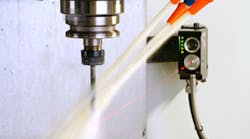The TRS2 tool recognition system offered by Renishaw plc is a cost-effective solution for reliable and rapid detection of broken tools on a wide range of machine tools and tool types, eliminating scrap, re-work, and downtime frequently caused by broken tools. Using Renishaw's ToolWise™ technology, tools as small as 0.2 mm (depending on the tool-surface finish and machine installation) diameter can be checked at 300 mm range. With tools typically spending 1 second in the laser beam, the TRS2 is also suitable for use in high volume production environments and for low, medium and high-speed spindle machines.
Renishaw develops technologies used for measurement, motion control, spectroscopy, and precision machining. For machine shops its probes for CNC machines make it possible to automate tool setting, workpiece set-up, in-cycle gauging, and part inspection. The TRS2 is a single compact unit that contains a laser source and detection electronics. It mounts easily outside a machine's working envelope, saving table space and keeping it safe from the risk of collision.
Set-up is simplified with dedicated control software, also from Renishaw. Tools can be detected at distances from 0.3 to 2.0 meters, depending on a tool's surface finish, machine environment and installation. The TRS2 is suitable for a wide range of machines, although it is optimized for use at distances of up to 1.0 meter.
Renishaw said the TRS2 replaces the original device, the TRS1, which is installed on machines worldwide. Enhancements to Renishaw's ToolWise pattern-recognition system for tool condition monitoring (e.g., radial and linear profile and cutting edge condition) improve the reliability of the TRS2’s detection capability, and reduce the cycle times.
Conventional non-contact broken tool detection systems depend on the laser beam being blocked (tool OK) or not blocked (tool broken). The TRS2 uses the tool-recognition electronics within the ToolWise technology to determine whether a tool is present by analyzing the reflected light pattern from the rotating tool. Random light patterns created by coolant and metal chips are ignored, thereby reducing the chance of not detecting a broken tool due to coolant blocking the beam.
An important benefit of this enhancement is the ability to work at a greater range of spindle speeds (200, 1,000, and 5,000 RPM), so it’s able to detect a greater range of tool types in a wider range of applications.
As an example, Renishaw said it’s now possible to monitor gun drill applications and high-speed spindle machines, so there is less time spent waiting for spindles to slow down for inspection. The TRS2 also is more reliable at detecting small, dark tools, and it can detect a wider range of solid-center tools like drills, taps, end mills, slot drills, and ball-nose end mills.







